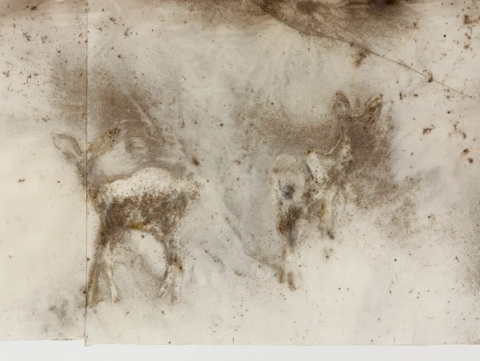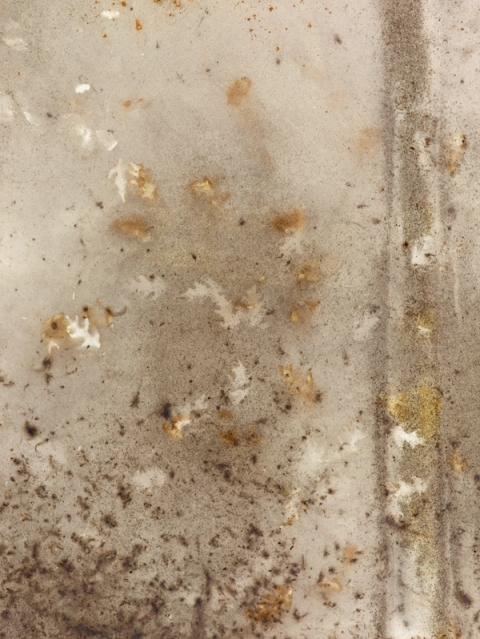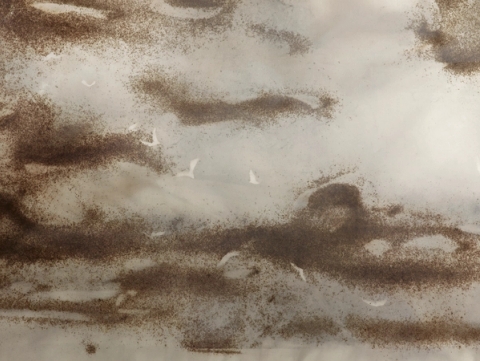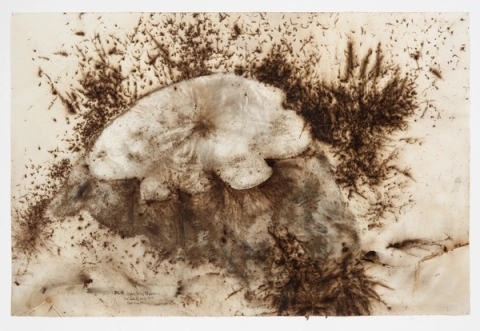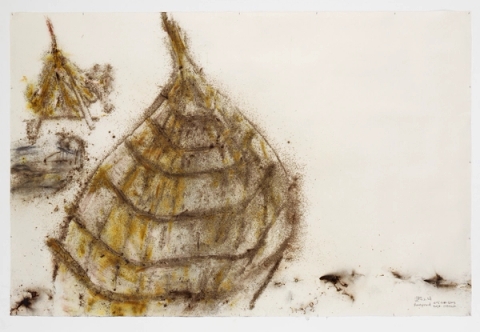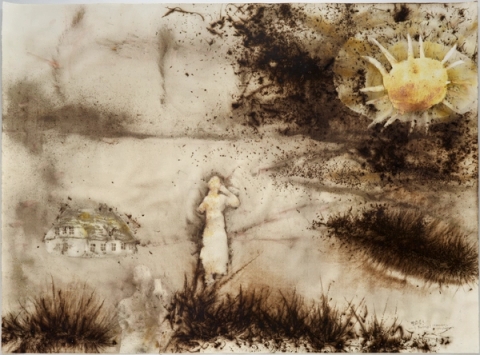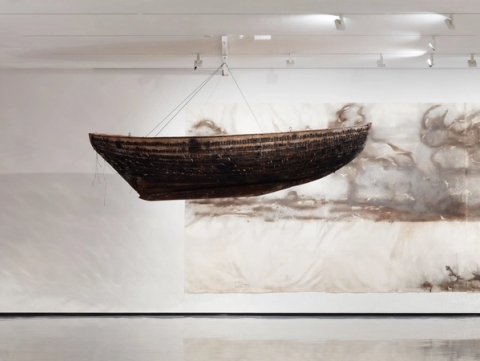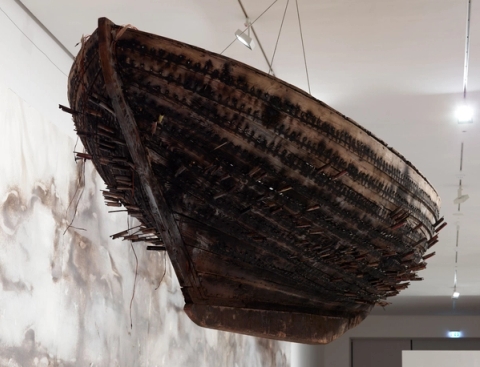
For Faurschou Foundation's inaugural exhibition, Cai Guo-Qiang has referenced the foundation's new location in the Free Port of Copenhagen, as well as the country's historical and cultural connection to the sea.
The exhibition revisits several prominent themes in Cai's oeuvre, such as the ocean, voyages, and cross-cultural encounters.
The exhibition includes a series of newly commissioned gunpowder drawings inspired by Denmark's nature, culture, and history. It also highlights Reflection-A Gift from Iwaki (2004), part of the foundation's collection, as the centerpiece, surrounded by its own reflection and that of the drawings from the mirror flooring.
On the day of the opening, Cai ignited thousands of mini rockets from a small traditional Danish boat Freja on the water behind the foundation, in front of an enthusiastic crowd from all over Denmark and beyond. The scorch marks from the explosion transformed the boat into a three-dimensional gunpowder drawing, and this sculpture subsequently becomes a part of the exhibition, generating a dialogue with Reflection-A Gift from Iwaki.
Three videos are also shown in the gallery, documenting the process of the exhibition: Cai's site visits to different locations in Denmark and the making of the gunpowder drawings; the story of Reflection - A Gift from Iwaki, and the preparation and explosion of 'Freja: Explosion Event for Faurschou Foundation.'
A Clan of Boats
Since childhood, Cai has held a special fascination with boats, a familiar symbol he grew up with in the harbour city of Quanzhou, China, which appear constantly throughout his repertoire. A Clan of Boats allows Cai to recount a number of them, which he refers to as his 'children'. Among them is the Faurschou Foundation's own Reflection - A Gift from Iwaki.
A wreck filled with broken white porcelain from Dehuain Cai's hometown, the work has been shown at many important museums around the world. Each time the team of Iwaki volunteers, who excavated the boat as a gift to commemorate their friendship with Cai since 1994, would arrive on site to install the hull, just as they did for 'A Clan of Boats', and they are very much part of the work.
A visit to the Viking Ship Museum on the Roskilde Fjord inspired the artist to construct a conversation between 'Reflection - A Gift from Iwaki', the Viking shipbuilding practice, and the Danish landscape. The sand dunes covered with lyme grass under the dramatic clouds along the shore of northwestern Jutland intrigued Cai, and the custom of fishermen taking their boats ashore rather than docking at the port. The Nordic shipbuilding tradition also brought Cai to Jægersborg Hegn, where centuries-old oaks stand, originally cultivated for an invincible fleet. Nearby in the Jægersborg Dyrehave, a horse-drawn carriage ride showed the artists herds of deer grazing peacefully in what was once the royal hunting ground.
The experience from Cai's local excursions culminated in the gunpowder drawings enveloping the gallery space, produced entirely on site with the assistance of local volunteers.
Cai and Danmark
Before exhibiting at some of the most prestigious museums in the world, Cai held his first solo exhibition in the Western world in Denmark. When Louisiana Museum of Modern Art presented Flying Dragon in the Heavens in 1997, Cai stayed at the museum's boathouse for over a month. It was then he developed an interest in the history and seafaring traditions of the Vikings.
Cai Guo-Qiang
Cai Guo-Qiang was born in 1957 in Quanzhou, Fujian Province, China. Trained in stage design at the Shanghai Theater Academy, his work has since crossed multiple mediums within art, including drawing, installation, video and performance. While living in Japan from 1986 to 1995, he explored the properties of gunpowder in his drawings, an inquiry that eventually led to his experimentation with explosives on a massive scale and to the development of his signature explosion events. Drawing upon Eastern philosophy and contemporary social issues as a conceptual basis, these projects aim to establish an exchange between viewers and the larger universe around them, utilizing a site-specific approach to culture and history.
Cai was awarded the Golden Lion at the 48th Venice Biennale in 1999, the 7th Hiroshima Art Prize in 2007, and the 20th Fukuoka Asian Culture Prize in 2009. He also served as Director of Visual and Special Effects for the Opening and Closing Ceremonies of the 2008 Summer Olympics in Beijing. Recently his first ever solo exhibition in a Middle Eastern country, Cai Guo-Qiang: Saraab opened in December 2011 in Doha, Qatar. In spring 2012, the artist appeared in two solo exhibitions: Cai Guo-Qiang: Sky Ladder (Museum of Contemporary Art, Los Angeles) and Cai Guo-Qiang: Spring (Zhejiang Art Museum, Hangzhou, China). He currently lives and works in New York.



Cai Guo-Qiang was born in 1957 in Quanzhou, China. In 1986 he moved to Japan and began working with gunpowder, which led to the development of his unique outdoor-explosion events. His works include drawings, installations, video and performance art. He has been living and working in New York since 1995.
Having grown up in the port of Quanzhou, which was once known as the largest harbour in the world, Cai has always been fascinated by boats. Included in many of his works, boats can be seen as cultural vessels that link people and places. They enable cultural exchange, in particular between Asia and the West. For Cai, the boat can also be regarded as a spacecraft, linking the earth to the universe-thus, making it a symbol for crossing national boundaries, time zones, mentalities, and galaxies.
For the inaugural exhibition at Foruschou Foundation, 'A Clan of Boats', Cai Gou-Qiang used his signature explosive expression and reference to the sea. On the day of the opening, Cai ignited thousands of mini rockets from the small traditional Danish boat 'Freja', in front of an enthusiastic crowd from all over Denmark and beyond. The scorch marks from the explosion transformed the boat into a three-dimensional gunpowder drawing, which subsequently became a part of the exhibition. These new additions for the art exhibition 'A clan of boats' generated dialogue with the famed work Reflection-A Gift from Iwaki (2004), which is part of the Faurschou collection.
The artworks of Cai Gou-Qiang are significant pieces in the Faurschou Foundation art collection and have been exhibited for an appreciative crowd in Copenhagen. For the exhibition 'I look at things…' (2014), Faurschou Foundation drew on the expression of artists from both west and east, combining and creating a dialogue between different cultures and different artistic practices. On this occasion, Cai Guo-Qiang’s work, 'A Boat with Dreams' (2008), was floating from the ceiling of the exhibition space. This artwork, also part of the Faurschou Foundation’s art collection, is one of his more poetic expressions: a small wooden boat full to the brim with glowing red paper lanterns shaped like rockets, cars, stars and other objects from his memory.

For most spectators, each of these explosions was a memorable example of Cai using the sky as “a canvas,” albeit for a few fleeting seconds.
Karen Smith: Cai Guo-Qiang - A Clan of Boats
Chen Zhen
Même lit, rêves differents







